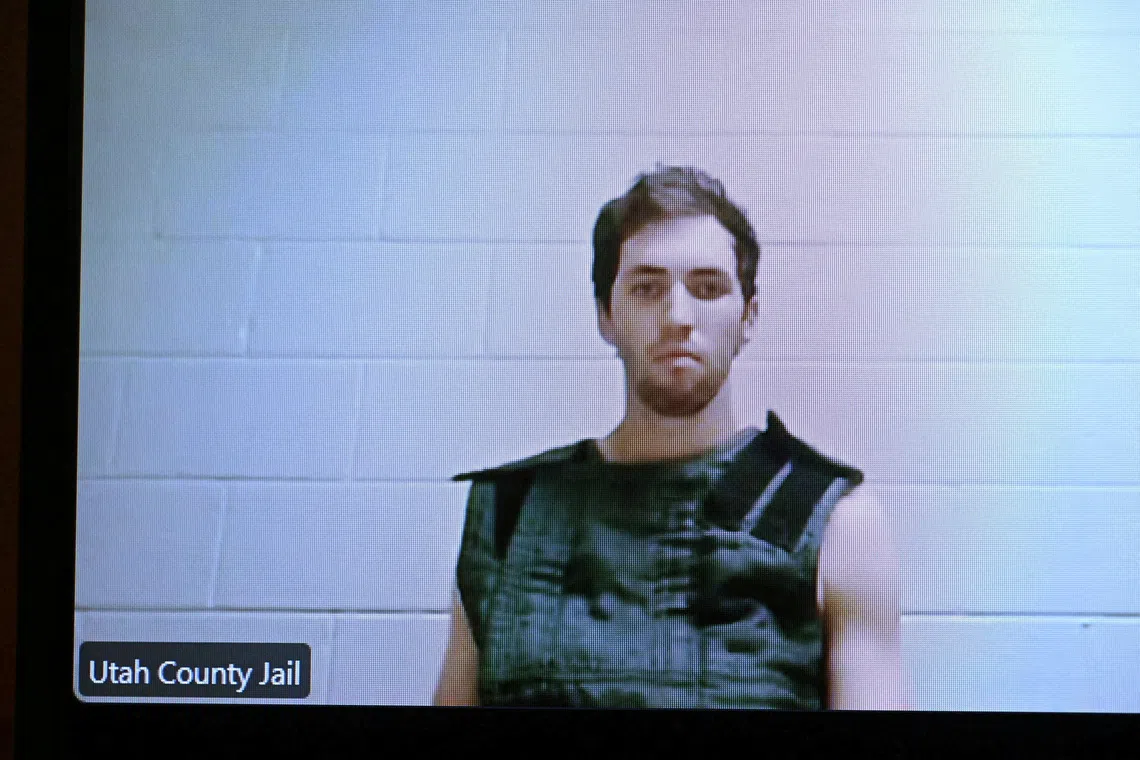Unresolved questions hang over case against Charlie Kirk’s accused killer
Sign up now: Get ST's newsletters delivered to your inbox

The precise motives of Tyler Robinson, 22, the suspect in the shooting death of Mr Charlie Kirk, is yet to be made clear.
PHOTO: REUTERS
Follow topic:
A day after Utah prosecutors unveiled formal charges against the suspect in the assassination of conservative activist Charlie Kirk, questions remain about how he planned the shooting, his precise motives for killing Mr Kirk,
Prosecutors began outlining the case against 22-year-old Tyler Robinson on Sept 16, when he appeared in court via video feed from jail to face capital murder and other charges.
But the charging documents revealed gaps that investigators will likely try to fill in the coming months, experts said.
The details of the killing – and what specifically drove the gunman to carry it out – have taken on outsized importance, given the political firestorm surrounding Mr Kirk’s death.
The attack has deepened fears about rising political violence
“I would certainly, and I'm sure the public would, like to know a lot more about exactly what motivated him,” said retired FBI special agent Kenneth Gray, a professor of practice at the University of New Haven.
Mr Kirk, 31, was killed by a single round to the neck during a campus event at Utah Valley University that drew a crowd of about 3,000.
In a text to his roommate, whom officials have said was also a romantic partner, Robinson said he had planned the attack for “a bit over a week”.
But prosecutors have offered little detail about Robinson’s preparations.
Surveillance camera footage captured him arriving on campus around 8.30am, according to last week’s initial arrest affidavit.
Hours later, he was recorded re-entering campus and going to the rooftop from where he fired the shot at Mr Kirk, who was seated about 146m away during the outdoor event, according to court documents filed on Sept 16.
His lack of hesitation indicated he had conducted some reconnaissance before climbing to the roof, Professor Gray said.
“He had to know where would be a good position and not just pick one on the fly,” he added.
Former New York police detective Felipe Rodriguez, an adjunct professor at John Jay College of Criminal Justice at The City University of New York, also said it seemed clear that the suspect conducted reconnaissance before the shooting.
“How else did he know there were no alarms on the building, on the door to the roof?” he said. “How did he know he could make the shot?”
Firearms experts said the shot itself was not particularly challenging, given the weapon of choice: a bolt-action rifle with a scope that had once belonged to Robinson’s grandfather, according to court documents.
Mr Jim Gilliland, a former Army Ranger sniper and a long-distance shooting competitor, said: “For someone with a decent rifle and modern ammunition, it’s not a difficult shot whatsoever.” He added that even a novice could pull it off with a properly calibrated rifle.
Most competitors would not consider a shot from fewer than 457m away to be “long range”, he said.
Family photos posted by Robinson’s mother on Facebook showed the suspect and his brother holding guns in the past, suggesting they had some shooting experience.
Prosecutors said they found targets with bullet holes in Robinson’s home.
Hunting is popular in Utah, where more than 280,000 annual hunting licences were issued in 2024, or about one for every 10 residents.
It was not clear whether Robinson held one, as the state does not disclose such information.
Bolt-action rifles, which require the user to load each round manually, are popular among hunters, target shooters and military snipers, and are seen as more accurate than semi-automatic rifles at longer distances.
Motivation not yet fully known
While the initial evidence provided clues as to Robinson’s motives, much remains unclear about exactly what may have driven him to kill Mr Kirk.
Adjunct Professor Rodriguez said: “We always want to know why.
“Police need it to help establish the case, and prosecutors need it as that one last piece of the puzzle to present to a jury.”
In texts to his roommate, Robinson said he had killed Mr Kirk because “I had enough of his hatred”, according to transcripts of the exchanges in court filings.
Robinson’s mother told investigators that his political views had moved left recently, and that he had become “more pro-gay and trans-rights oriented”, prosecutors said.
Investigators said his roommate, who is cooperating with the authorities, was “transitioning genders”.
Mr Kirk, a co-founder of Turning Point USA, the country’s leading conservative youth group, was a provocateur known for rhetoric that civil rights groups have criticised as racist, anti-immigrant, transphobic and misogynistic.
His backers say he was a defender of conservative values and a champion of public debate who helped boost Mr Trump’s popularity among young voters.
Prosecutors have not said which specific viewpoints of Mr Kirk’s that Robinson found hateful, or whether his partner’s gender identity may have played a role.
Utah County’s chief prosecutor Jeffrey Gray said on Sept 16 that he would not share details beyond what was in the charging document to ensure a fair jury trial.
The authorities have also said they are still examining whether anyone else may have known about the pending attack.
University of New Haven professor Bobby McDonald, who is also a former Secret Service agent, said: “How did he get radicalised?
“How we learn about what happened to him might not stop the next shooting, but maybe help us see the warning signs.” REUTERS

